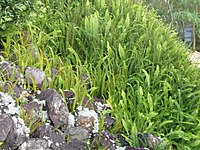Nephrolepis cordifolia
| Nephrolepis cordifolia | |
|---|---|

| |
| Scientific classification | |
| Kingdom: | Plantae |
| Clade: | Tracheophytes |
| Division: | Polypodiophyta |
| Class: | Polypodiopsida |
| Order: | Polypodiales |
| Suborder: | Polypodiineae |
| Family: | Nephrolepidaceae |
| Genus: | Nephrolepis |
| Species: | N. cordifolia
|
| Binomial name | |
| Nephrolepis cordifolia (L.) K. Presl
| |
| Synonyms | |
| |
Nephrolepis cordifolia, is a fern native to the global tropics, including northeastern Australia and Asia. It has many common names including fishbone fern, tuberous sword fern, tuber ladder fern, erect sword fern, narrow sword fern and ladder fern, and herringbone fern.[1] It is similar to the related fern Nephrolepis exaltata.
Description
Nephrolepis cordifolia is an evergreen fern that grows to between 40 and 80 centimeters, in extreme cases up to 1 meter. It forms an underground rhizome in the form of several small tubers. The pinnate fronds are erect and pinnate linear to lanceolate, glandular and simple. The rachis bears bicolored chaff scales. The petiole is covered with bicolored pale and dark brown scales.
The leaflets are entire, sessile and elongate-lanceolate. They grow up to 4.8 centimeters long and up to 0.9 cm wide. They stand at a distance of less than 1 centimeter. The sori are rounded. The spores are warty, wrinkled.
Distribution
The species is native in north-eastern Australia and on the slopes of the Himalayas, and is considered naturalised on the central east coast of New South Wales.[1] They can grow both terrestrially and as an epiphyte. However, the species grows very rarely as an epiphyte. It grows mainly in moist, shady groves, rock faces, roadsides, on old walls or ruins. It loves moist, shady locations and is commonly found in swamps and floodplains in coniferous forests.
It has been introduced into Bermuda, French Polynesia, New Zealand, and the United States.[2] It is also widely distributed by humans and is currently found in tropical regions of North, Central and South America (mainly in Mexico, the Caribbean and Florida), in Africa, Southeast Asia, the islands of the Pacific and on the Azores. In the Hawaiian Islands it is known as kupukupu, okupukupu or ni'ani'au [3]
Invasive species
Nephrolepis cordifolia has become an invasive species is some areas where it has been introduced. In New Zealand it is listed on the National Pest Plant Accord, which prohibits the sale, cultivation and distribution of the plant. It is listed as an invasive species in Florida, United States.[4]
Gallery
'Nephrolepis cordifolia spreading on a forest and pasture margin in the Waikato region in New Zealand
Nephrolepis cordifolia 'Duffii' at Garfield Park Conservatory
Nephrolepis cordifolia at the New York Botanical Garden
References
- ^ a b "Nephrolepsis cordifolia". PlantNet - FloraOnline. Retrieved 30 December 2012.
- ^ "Nephrolepis cordifolia". Global Invasive Species Database (Invasive Species Specialist Group). Retrieved 8 November 2011.
- ^ Growing plants for Hawaiian lei : 85 plants for gardens, conservation, and business. Honolulu: College of Tropical Agriculture and Human Resources, University of Hawaiʻi at Mānoa. 2002. p. 24. ISBN 1929325134.
- ^ "Nephrolepis cordifolia" (PDF). Florida Exotic Pest Plant Council. Retrieved 8 November 2011.
External links
- Nephrolepis cordifolia at the Global Invasive Species Database (Invasive Species Specialist Group)
- "Nephrolepis cordifolia". Integrated Taxonomic Information System. Retrieved 2011-11-07.
- Nephrolepis cordifolia at Weedbusters (New Zealand)
- Nephrolepis cordifolia at the Center for Invasive Species and Ecosystem Health (United States)Error: "Q1040814" is not a valid Wikidata entity ID.
- Articles with short description
- Short description with empty Wikidata description
- Articles with 'species' microformats
- Commons category link is the pagename
- Taxonbars desynced from Wikidata
- Taxonbar pages requiring a Wikidata item
- Taxonbars with invalid from parameters
- Taxonbars without secondary Wikidata taxon IDs
- Nephrolepis
- Flora of Nepal
- Flora of Australia
- Garden plants of Australia







